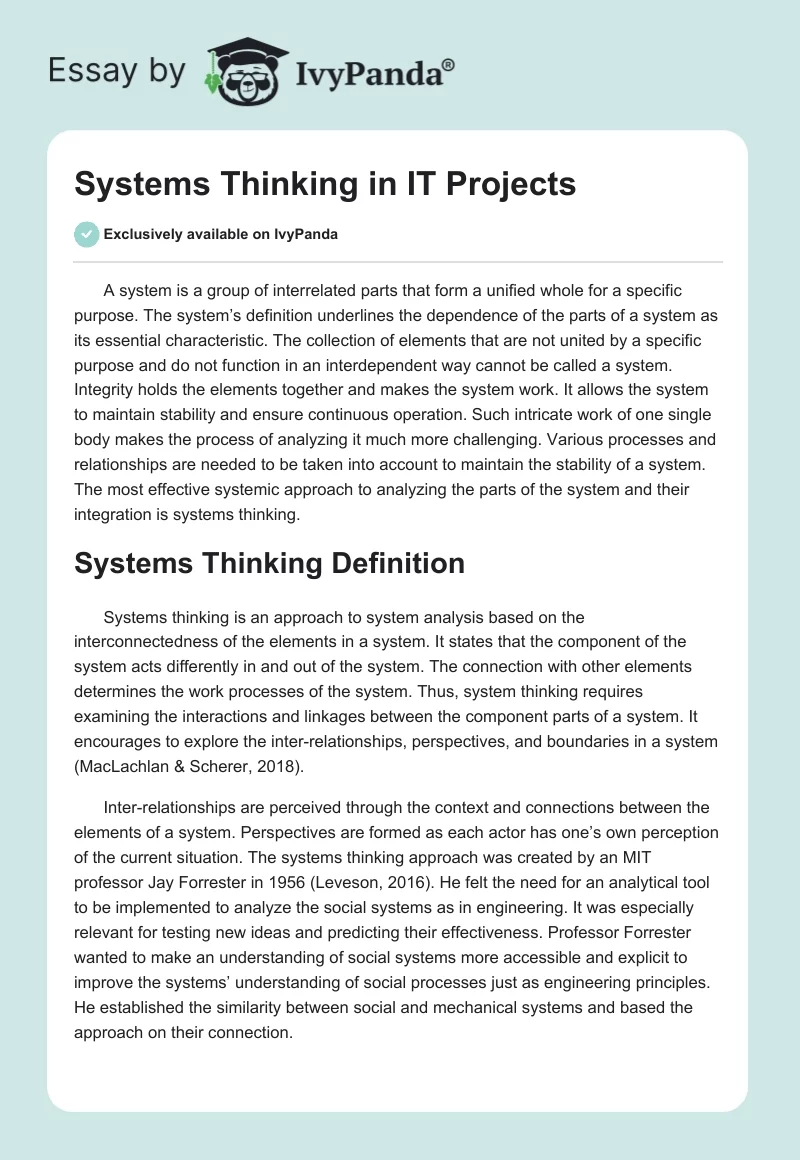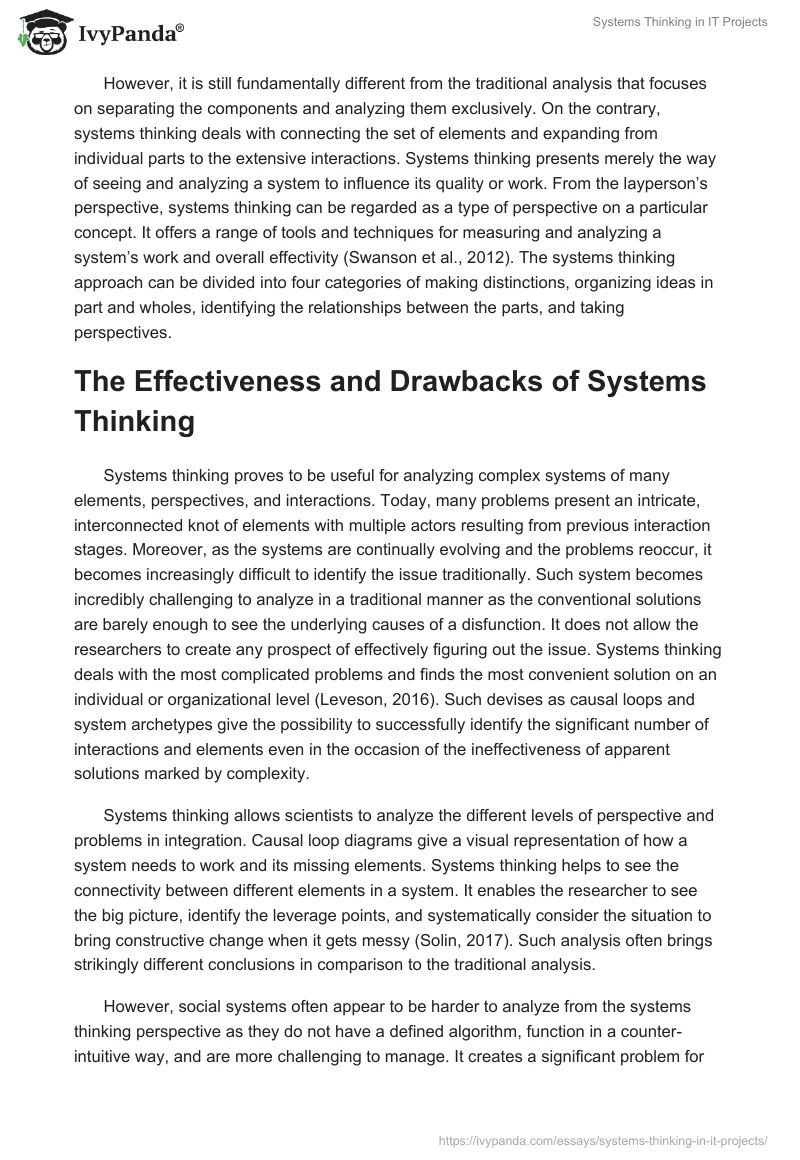A system is a group of interrelated parts that form a unified whole for a specific purpose. The system’s definition underlines the dependence of the parts of a system as its essential characteristic. The collection of elements that are not united by a specific purpose and do not function in an interdependent way cannot be called a system. Integrity holds the elements together and makes the system work. It allows the system to maintain stability and ensure continuous operation. Such intricate work of one single body makes the process of analyzing it much more challenging. Various processes and relationships are needed to be taken into account to maintain the stability of a system. The most effective systemic approach to analyzing the parts of the system and their integration is systems thinking.
Systems Thinking Definition
Systems thinking is an approach to system analysis based on the interconnectedness of the elements in a system. It states that the component of the system acts differently in and out of the system. The connection with other elements determines the work processes of the system. Thus, system thinking requires examining the interactions and linkages between the component parts of a system. It encourages to explore the inter-relationships, perspectives, and boundaries in a system (MacLachlan & Scherer, 2018).
Inter-relationships are perceived through the context and connections between the elements of a system. Perspectives are formed as each actor has one’s own perception of the current situation. The systems thinking approach was created by an MIT professor Jay Forrester in 1956 (Leveson, 2016). He felt the need for an analytical tool to be implemented to analyze the social systems as in engineering. It was especially relevant for testing new ideas and predicting their effectiveness. Professor Forrester wanted to make an understanding of social systems more accessible and explicit to improve the systems’ understanding of social processes just as engineering principles. He established the similarity between social and mechanical systems and based the approach on their connection.
However, it is still fundamentally different from the traditional analysis that focuses on separating the components and analyzing them exclusively. On the contrary, systems thinking deals with connecting the set of elements and expanding from individual parts to the extensive interactions. Systems thinking presents merely the way of seeing and analyzing a system to influence its quality or work. From the layperson’s perspective, systems thinking can be regarded as a type of perspective on a particular concept. It offers a range of tools and techniques for measuring and analyzing a system’s work and overall effectivity (Swanson et al., 2012). The systems thinking approach can be divided into four categories of making distinctions, organizing ideas in part and wholes, identifying the relationships between the parts, and taking perspectives.
The Effectiveness and Drawbacks of Systems Thinking
Systems thinking proves to be useful for analyzing complex systems of many elements, perspectives, and interactions. Today, many problems present an intricate, interconnected knot of elements with multiple actors resulting from previous interaction stages. Moreover, as the systems are continually evolving and the problems reoccur, it becomes increasingly difficult to identify the issue traditionally. Such system becomes incredibly challenging to analyze in a traditional manner as the conventional solutions are barely enough to see the underlying causes of a disfunction. It does not allow the researchers to create any prospect of effectively figuring out the issue. Systems thinking deals with the most complicated problems and finds the most convenient solution on an individual or organizational level (Leveson, 2016). Such devises as causal loops and system archetypes give the possibility to successfully identify the significant number of interactions and elements even in the occasion of the ineffectiveness of apparent solutions marked by complexity.
Systems thinking allows scientists to analyze the different levels of perspective and problems in integration. Causal loop diagrams give a visual representation of how a system needs to work and its missing elements. Systems thinking helps to see the connectivity between different elements in a system. It enables the researcher to see the big picture, identify the leverage points, and systematically consider the situation to bring constructive change when it gets messy (Solin, 2017). Such analysis often brings strikingly different conclusions in comparison to the traditional analysis.
However, social systems often appear to be harder to analyze from the systems thinking perspective as they do not have a defined algorithm, function in a counter-intuitive way, and are more challenging to manage. It creates a significant problem for the system thinking approach because individual systems’ outcomes remain unclear, so it is impossible to determine how to produce better results logically (Farmer, 2009). That is why it is especially important to determine the system’s purpose to fix the recurring mistake. The inability to find the system’s root purpose and design causes the systems thinking failure as the outcomes cannot be predetermined.
Systems thinking in IT projects appears to be especially relevant as these projects usually have multiple interconnected elements in a complex system. The larger the project is, the easier it becomes to analyze how each component affects the outcome in a system. IT sector often faces the issue of the recurring mistake that prevents the code from functioning effectively in complex projects. Systems thinking gives the tool of determining the causes of the outcome failure through the in-depth analysis of the system elements’ relationships.
References
Farmer, P. (2009). The need for “systems thinking” in health care[Video file]. Web.
Leveson, N. G. (2016). Engineering a safer world: Systems thinking applied to safety. Cambridge, MA: The MIT Press.
MacLachlan, M., & Scherer, M. J. (2018). Systems thinking for assistive technology: a commentary on the GREAT summit.Disability and Rehabilitation: Assistive Technology, 13(5), 492-496. Web.
Swanson, R. C., Cattaneo, A., Bradley, E., Chunharas, S., Atun, R., Abbas, K. M.,… & Best, A. (2012). Rethinking health systems strengthening: Key systems thinking tools and strategies for transformational change.Health Policy and Planning, 27(4), 54-61. Web.
Solin, J. (2017). Book review of systems thinking made simple: New hope for solving wicked problems. Journal of Sustainability Education, 12, 1-4.


